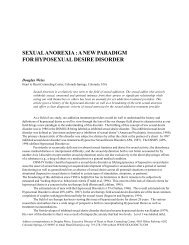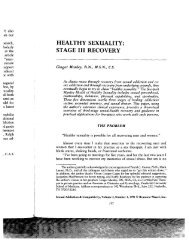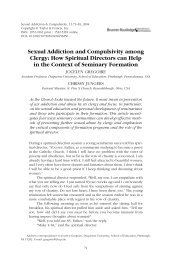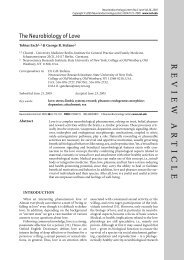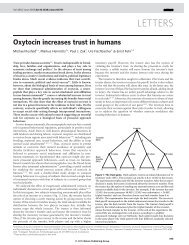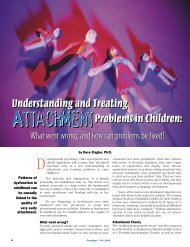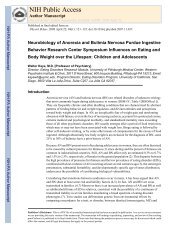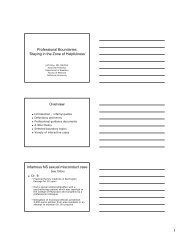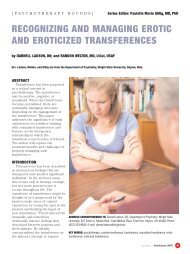Treating the Sexually Addicted Client
Treating the Sexually Addicted Client
Treating the Sexually Addicted Client
You also want an ePaper? Increase the reach of your titles
YUMPU automatically turns print PDFs into web optimized ePapers that Google loves.
Articles<strong>Treating</strong> <strong>the</strong> <strong>Sexually</strong> <strong>Addicted</strong> <strong>Client</strong>:Establishing a Need for IncreasedCounselor AwarenessW. Bryce HagedornGerald A. JuhnkeSeventeen to 37 million Americans struggle with sexual addictions (P. Carnes,1994b; A. Cooper, D. L. Delmonico, & R. Burg, 2000; B. Morris, 1999; & J. L.Wolf, 2000)), yet traditionally trained addictions and offender counselorsoften find <strong>the</strong>mselves unprepared to assist clients who are sexually addicted.This article provides a general overview of <strong>the</strong> disorder, explores <strong>the</strong>ongoing definition debate, and offers clinically proven treatment protocols.The suggested prevalence of sexual addiction is staggering. An estimated 17 to37 million Americans struggle with this addictive disorder (Carnes, 1994b; Cooper,Delmonico, & Burg, 2000; Morris, 1999; Wolfe, 2000). These figures are greaterthan <strong>the</strong> combined number of Americans who are addicted to gambling or haveeating disorders (National Center on Addiction and Substance Abuse at ColumbiaUniversity, 2003; Potenza, Fiellin, Heninger, Rounsaville, & Mazure, 2002;Shaffer & Korn, 2002; Tenore, 2001). In addition to <strong>the</strong> prevalence, <strong>the</strong> incidenceof sexual addiction is rising, due in part to <strong>the</strong> affordability, accessibility, andanonymity of sexually explicit material available on <strong>the</strong> Internet (Cooper et al.,2000). The prevalence of sexual addiction is predicted, based on current trends,to continue rising at a rapid rate (Cooper, 2004).Because of <strong>the</strong> lack of qualified counselors, many addicted individuals turn toself-help groups, all of which are administered by nonprofessionals without formaleducation and training in treating sexual addiction (Haugh, 1999; Myers, 1995;Wolfe, 2000). Of <strong>the</strong> 73 nationally known 12-step, self-help support groups, 8 distinctgroups are dedicated to individuals seeking assistance in managing <strong>the</strong>ir sexuallyaddictive behaviors. This number of sexual addiction support groups is morethan any o<strong>the</strong>r 12-step group addressing an addictive disorder and may reflect<strong>the</strong> large number of individuals who are sexually addicted. Despite steadily in-W. Bryce Hagedorn, Department of Educational and Psychological Studies, Florida InternationalUniversity; Gerald A. Juhnke, Department of Counseling and Educational Development,University of North Carolina at Greensboro. Gerald A. Juhnke is now in <strong>the</strong> Department ofCounseling, Educational Psychology, Adult and Higher Education, The University of Texas atSan Antonio. Correspondence concerning this article should be addressed to W. Bryce Hagedorn,Department of Educational and Psychological Studies, ZEB 239A, Florida International University,Miami, FL 33199 (e-mail: hagedorn@fiu.edu).66 Journal of Addictions & Offender Counseling •April 2005 •Volume 25
creasing self-referral and participation in 12-step, self-help groups such asSexaholics Anonymous, Sex and Love Addicts Anonymous, Sex Addicts Anonymous,Sexual Compulsives Anonymous, and Sexual Recovery Anonymous, <strong>the</strong>treatment community lacks <strong>the</strong> resources and funding to address this growingpopulation (National Council on Sexual Addiction and Compulsivity, 2000).Although <strong>the</strong> increase in <strong>the</strong> number of 12-step groups specific to <strong>the</strong> treatmentof sexual addiction is a commendable step, <strong>the</strong>re is a growing need for addictionsand offender counselors to respond to <strong>the</strong> needs of <strong>the</strong> population of clients whoare sexually addicted. Although a very limited number of articles related to sexualaddiction have been published, <strong>the</strong>se articles have typically been published in journalsspecific to o<strong>the</strong>r clinician groups. For example, Carnes (1990) presented his earlyfindings in <strong>the</strong> American Journal of Preventive Psychiatry & Neurology, Goodman(1993) offered a definition and some treatment suggestions in <strong>the</strong> Journal of Sexand Marital Therapy, and Myers (1995) explored <strong>the</strong> impact of addictive sexualbehavior in <strong>the</strong> American Journal of Psycho<strong>the</strong>rapy. A specific journal, Sexual Addiction& Compulsivity, was created in 1993 to provide a forum for authors and researchersto provide information regarding sexual addiction (e.g., Delmonico & Griffin,1997; Goodman, 2001; Manley & Koehler, 2001; Ragan & Martin, 2000). Whereasthis demonstrates <strong>the</strong> importance and timeliness of information pertinent to treatingclients who are sexually addicted, this information has been disseminated to mostclinician groups, with <strong>the</strong> exception of addictions and offender counselors. Psychiatrists,sex and marital <strong>the</strong>rapists, psycho<strong>the</strong>rapists, even those working specificallywith sexual addicts, all have <strong>the</strong> necessary scholarly resources at <strong>the</strong>irdisposal to aid in <strong>the</strong>ir work with this client population. As of yet, no meta-analysisdefining sexual addiction and outlining <strong>the</strong> recommended treatment protocols hasbeen published for addictions and offender counselor generalists who are not specialistsworking exclusively with couples or persons who are sexually addicted.Concomitantly, no meta-analysis defining sexual addiction has been published in<strong>the</strong> Journal of Addictions & Offender Counseling. Therefore, <strong>the</strong> intent of this articleis to (a) define this disorder according to <strong>the</strong> existing literature; (b) establish <strong>the</strong>need for professionals working in <strong>the</strong> addictions and criminal justice fields to knowabout sexual addiction; and (c) offer clinically proven treatment protocols to assistwith <strong>the</strong> assessment, diagnosis, and treatment of clients who are sexually addicted.Defining Sexual AddictionPatrick Carnes (1994b), a pioneer in <strong>the</strong> sexual addiction field since 1976, notedthat compulsive sexual behaviors resembled <strong>the</strong> progressive and chronic compulsivebehaviors commonly found with o<strong>the</strong>r addictions. For this reason, Carneschose to use <strong>the</strong> term sexual addiction to describe a set of maladaptive behaviorsthat were uncontrollable, that brought negative consequences upon <strong>the</strong>addicted individual, and that harmfully affected those involved with <strong>the</strong> addictedindividual. He fur<strong>the</strong>r noted that, similar to <strong>the</strong> early days when publiceducation on alcoholism spurred both ignorance and prejudice, controversy about<strong>the</strong> use of <strong>the</strong> term sexual addiction was to be expected.Journal of Addictions & Offender Counseling •April 2005 •Volume 25 67
Criteria Development for <strong>the</strong> Addictive DisorderIn working toward defining <strong>the</strong> addictive disorder, Carnes (1992), Goodman (1998,2001), Levin (1999), and Young (1999) suggested that one begin by identifying<strong>the</strong> key elements used to identify chemical dependency. The fact that nei<strong>the</strong>r tolerancenor withdrawal is necessary for designating a behavior or substance asaddictive (American Psychiatric Association [APA], 2000; O’Brien, 1996; Potenzaet al., 2002) is an issue that we address in more detail later in this article. Therefore,we begin with <strong>the</strong> conditions that are both necessary and sufficient for <strong>the</strong>diagnosis of a dependence/addictive disorder.Goodman (2001) suggested that <strong>the</strong> two criteria necessary and sufficient for <strong>the</strong>designation of drug addiction are “(1) recurrent failure to control <strong>the</strong> use of oneor more drugs, and (2) continuation of drug use despite substantial harmful consequences”(p. 195). To arrive at a concise definition of an addictive disorder,Goodman (a) substituted <strong>the</strong> word behavior for drug in <strong>the</strong> above conditions and(b) added key elements from those arguments asserting that addictive behaviorsare better defined within <strong>the</strong> context of a compulsion or an impulse control disorder.An addictive disorder can <strong>the</strong>refore be defined asA behavior that can function both to produce pleasure and to reduce painful affects isemployed in a pattern that is characterized by two key features: (1) recurrent failure tocontrol <strong>the</strong> behavior, and (2) continuation of <strong>the</strong> behavior despite substantial harmfulconsequences. (p. 195)Similar definitions have been applied to designate gambling (Blaszcynski, Buhrich,McConaghy, 1985; Buchta, 1995; Griffiths, 1992; Potenza et al., 2002), <strong>the</strong> Internet(Armstrong et al., 2000; Young, 1999; Young, Pistner, O’ Mara, & Buchanan, 1999),and eating disorders (Baker, 1995; Flood, 1989; Sheppard, 1995) as addictive disorders.If one accepts <strong>the</strong> merits of this definition for an addictive disorder, <strong>the</strong> nextstep is to specify diagnostic criteria. In developing such criteria, Goodman (1993),Levin (1999), and Young (1999) began with comparing <strong>the</strong> criteria for compulsivegambling with <strong>the</strong> criteria established for substance dependence as found in<strong>the</strong> Diagnostic and Statistical Manual of Mental Disorders, fourth edition, textrevision (DSM–IV–TR; APA, 2000). In addition to <strong>the</strong> diagnostic criteria notedby each of <strong>the</strong>se authors, <strong>the</strong>y also noted three additional elements of sexualaddiction, namely, <strong>the</strong> factor of secrecy, <strong>the</strong> use of sex as an escape from dysphoricmood states, and <strong>the</strong> likelihood of engagement in illegal activities in pursuitof one’s addiction. Goodman (2001) <strong>the</strong>n combined <strong>the</strong> criteria and substituted<strong>the</strong> term behavior for <strong>the</strong> terms substance and substance use found in <strong>the</strong> substancedependence criteria. In addition, “characteristic withdrawal syndrome for<strong>the</strong> substance” (APA, 2000, p. 197) was replaced with a more universal definitionfor withdrawal that applied to all addictive behaviors.We <strong>the</strong>refore suggest that <strong>the</strong> following set of criteria be accepted as clinicallyrelevant for diagnosing an addictive disorder:A maladaptive pattern of behavior, leading to clinically significant impairment or distress,as manifested by three (or more) of <strong>the</strong> following, occurring at any time in <strong>the</strong>same 12-month period:Journal of Addictions & Offender Counseling •April 2005 •Volume 25 69
1. tolerance, as defined by ei<strong>the</strong>r of <strong>the</strong> following:a. a need for markedly increased amount or intensity of <strong>the</strong> behavior to achieve <strong>the</strong>desired effectb. markedly diminished effect with continued involvement in <strong>the</strong> behavior at <strong>the</strong> samelevel or intensity2. withdrawal, as manifested by ei<strong>the</strong>r of <strong>the</strong> following:a. characteristic psychophysiological withdrawal syndrome of physiologically describedchanges and/or psychologically described changes upon discontinuation of <strong>the</strong> behaviorb. <strong>the</strong> same (or a closely related) behavior is engaged in to relieve or avoid withdrawalsymptoms3. <strong>the</strong> behavior is often engaged in over a longer period, in greater quantity, or at a higherintensity than was intended4. <strong>the</strong>re is a persistent desire or unsuccessful efforts to cut down or control <strong>the</strong> behavior5. a great deal of time spent in activities necessary to prepare for <strong>the</strong> behavior, to engage in<strong>the</strong> behavior, or to recover from its effects6. important social, occupational, or recreational activities are given up or reduced because of <strong>the</strong> behavior7. <strong>the</strong> behavior continues despite knowledge of having a persistent or recurrent physical orpsychological problem that is likely to have been caused or exacerbated by <strong>the</strong> behavior(Goodman, 2001, pp. 195–196)To conclude, <strong>the</strong> establishment of diagnostic criteria appears to have severalmerits including, but not limited to, <strong>the</strong> creation of common clinical language,a legitimization of <strong>the</strong> disorder for <strong>the</strong> purposes of third-party reimbursement,and a step toward a standardized treatment protocol.The Addictive Disorder DebateTo address <strong>the</strong> validity of using <strong>the</strong> addictive disorder model for this article, itis necessary to address <strong>the</strong> literature that discounts, as well as affirms, sexualbehavior as addictive. Whereas <strong>the</strong>re is a plethora of literature that debates <strong>the</strong>merits of designating <strong>the</strong>se addictive behaviors as compulsions (e.g., Abouesh& Clayton, 1999), impulses (e.g., Hollander & Rosen, 2000), or paraphilias (e.g.,Kafka, 1997), <strong>the</strong> arguments addressed herein involve issues of dependence(e.g., physical withdrawal and tolerance) and recovery.In arguing against acknowledging sex as addictive, many authors address <strong>the</strong>physical dependence criteria often found with addictive substances. Apt andHulbert (1995) asserted that “A true addiction involves a physiological dependenceon a particular substance that results from <strong>the</strong> habitual use of that substance.Sex is a form of interaction, not a substance on which <strong>the</strong> body comes todepend” (p. 104). Levine and Troiden (1988) made similar claims in advocatingfor <strong>the</strong> retention of <strong>the</strong> term addiction for chemical substances when <strong>the</strong>yadded, “Although sexual experiences may be ‘mood altering,’ abrupt withdrawalfrom sexual behavior does not lead to forms of physiological distress such asdiarrhea, delirium, convulsions, or death” (p. 357). Finally, Barth and Kinder(1987) declared that any similarities between sexual and chemical addictiondo not overrule <strong>the</strong> original definition of addiction as a physiological dependence on aforeign substance, evidenced by <strong>the</strong> removal of that substance producing a physiologicalwithdrawal state. Sexual impulsivity involves no foreign substances or withdrawal states,and as such should not be labeled as an addiction. (p. 21)70 Journal of Addictions & Offender Counseling •April 2005 •Volume 25
The main argument made by <strong>the</strong>se authors is that for a behavior/substance to beaddictive, it must meet criteria for physical dependence, criteria exhibited bytolerance and withdrawal.Although <strong>the</strong>se arguments may have had merit in <strong>the</strong> past, current research refutessuch assertions. O’Brien (1996) stated that “Modern concepts of addictivedisorders emphasize <strong>the</strong> compulsive and relapsing drug-taking behaviors ra<strong>the</strong>rthan tolerance and physical dependence” (p. 677). Potenza et al. (2002), througha comprehensive study discussing <strong>the</strong> merits of designating gambling as an addictivedisorder ra<strong>the</strong>r than as an impulse control disorder, found that behavioraladdictions can be “considered an addiction without exogenous substanceuse” (p. 722).The DSM–IV–TR (APA, 2000) lists substances such as cannabis, cocaine, andhallucinogens, all of which have dependence criteria. It is interesting that none of<strong>the</strong>se substances cause physiological dependence but that all are considered “addictive”substances based on psychological dependence. Because maladaptive patternsof chemical use must meet 3 of 7 criteria to be designated as a dependence(versus abuse), it is likely that an individual can experience dependence withoutundergoing tolerance and withdrawal. In fact, according to <strong>the</strong> DSM–IV–TR,“Nei<strong>the</strong>r tolerance nor withdrawal is necessary or sufficient for a diagnosis ofSubstance Dependence” (APA, 2000, p. 194).Typical withdrawal symptoms from such substances as caffeine, cocaine, andmarijuana include <strong>the</strong> following: anxiety; depression; suicidal ideations; dysphoricmood states; irritability; changes in appetite; sleep disturbance; fatigue or drowsiness;cravings; and significant distress or impairment in social, occupational,or o<strong>the</strong>r important areas of functioning (APA, 2000). These same withdrawalsymptoms are seen in those who cease sexually addictive behavioral patterns(Carnes, 1994b; Goodman, 1998; Levin, 1999). Even opponents Levine andTroiden (1988) noted <strong>the</strong> high levels of anxiety experienced by sexual addictsin withdrawal. Although sexual addiction does not involve <strong>the</strong> ingestion of aforeign substance, <strong>the</strong> behavior patterns noted by Carnes (1992, 1994b),Goodman (1993, 2001), and o<strong>the</strong>rs appear to meet <strong>the</strong> criteria necessary for psychologicaldependence and withdrawal as noted by <strong>the</strong> DSM–IV–TR (APA, 2000).The o<strong>the</strong>r primary argument against classifying problematic, compulsive-likesexual behaviors as addictive concerns <strong>the</strong> issue of recovery from this disorder(Apt & Hulbert, 1995; Barth & Kinder, 1987; Levine & Troiden, 1988). The majorityof treatments for addictive disorders call for lifetime abstinence from alladdictive substances, but individuals who are sexually addicted are not expectedto abstain from having sex (Barth & Kinder, 1987; Goodman, 2001; Willenbring,2000). Apt and Hulbert (1995) claimed,A person with a sexual addiction is seldom urged to forgo sex entirely. Instead, he or sheis usually encouraged to find o<strong>the</strong>r, more appropriate forms of sexual expression. Aperson with a drug addiction is cured when he or she gives up <strong>the</strong> substance; a personwith an addiction to sex is cured when he or she confines his or her sexual activities toa culturally sanctioned pattern, such as a long-term relationship in which <strong>the</strong>re is emotionalintimacy and sexual reciprocity. (p. 104)Journal of Addictions & Offender Counseling •April 2005 •Volume 25 71
Apt and Hulbert fur<strong>the</strong>r contended that <strong>the</strong> only path to recovery for sexual addiction,similar to chemical addiction, is through total abstinence. Because thisgoal is not often <strong>the</strong> focus of treatment for sexual addiction (Carnes, 1992), opponentsto <strong>the</strong> addictive disorder model discount <strong>the</strong> addictive nature of sex.In response to <strong>the</strong> need for total abstinence as defined by <strong>the</strong> previously reviewedresearch, Goodman (2001) and Willenbring (2000) suggested a closer examinationof <strong>the</strong> definition and goal of abstinence. Although many of <strong>the</strong> 12-step fellowshipscall for total abstinence from all mood-altering drugs, <strong>the</strong> reality is that manyindividuals in recovery routinely ingest substances ei<strong>the</strong>r for pleasure (e.g., caffeineand nicotine) or for mental health purposes (e.g., Prozac for depression).Goodman (2001) recommended investigating what “functional qualities of unacceptabledrugs make <strong>the</strong>m unacceptable” (p. 202). An “unacceptable” drug for agiven individual would <strong>the</strong>refore be defined by that individual’s propensity to usethat drug addictively (as defined by a failure to control <strong>the</strong> use of <strong>the</strong> drug andcontinued use despite negative and harmful consequences). Therefore, Goodman’s(2001) recommended definition for drug abstinence would be “Abstaining from(not using) any drug that would be likely to be engaged in addictively” (p. 202).When defined in this manner, abstinence from sexual addiction would involve abstainingfrom any sexual behavior that results in (a) a failure to control that behavioror (b) <strong>the</strong> continuation of <strong>the</strong> behavior despite negative consequences. Whenabstinence from addictive behavior is understood in this context, lifetime abstinencefrom sexual addiction is more easily understood and attainable.To conclude <strong>the</strong> discussion of <strong>the</strong> addictive disorder, we want to emphasize that notall compulsive-like sexual behaviors are best explained as addictions. Whereas similarbehaviors can be part of ongoing personality disorders, obsessive/compulsive disorders,sexual paraphilias, or o<strong>the</strong>r disorders, <strong>the</strong> lack of a separate diagnosis foran addictive disorder (with accompanying criteria) leaves counselors withoutrelevant and appropriate diagnostic and treatment options.A Fundamental Understanding of Sexual AddictionIt is imperative that addictions and offender counselors have a fundamentalunderstanding of sexual addiction. This is especially true for counselors workingwith chemically addicted and court-referred clients. First, given that addictedpersons often exchange one addiction for ano<strong>the</strong>r, and because of <strong>the</strong> highcomorbidity between chemical and sexual addictions, counselors must be ableto recognize <strong>the</strong> presence of addictive behaviors (e.g., sexual) and interveneefficiently. Addictions professionals stand <strong>the</strong> risk of misdiagnosing clients when<strong>the</strong>y assume chemical dependency independent of o<strong>the</strong>r addictive behaviors(Manhal-Baugus, 1996). In reality, <strong>the</strong>re may be underlying sexual compulsionsdriving <strong>the</strong> overt and readily identifiable secondary, chemical addictions(Peck, 1993). <strong>Client</strong>s often first acknowledge <strong>the</strong>se secondary, chemical addictionsbecause such addictions are more socially acceptable than sexual addictions.Additional reasons for increased professional awareness of sexualaddiction include <strong>the</strong> comorbidity between psychiatric disorders and sexual72 Journal of Addictions & Offender Counseling •April 2005 •Volume 25
addiction and <strong>the</strong> efficacy of using a sexual addiction recovery model withincarcerated individuals.The Relationship Between Chemical and Process AddictionsSeveral studies have demonstrated <strong>the</strong> clear relationship between chemical andprocess addictions. Das (1990) demonstrated <strong>the</strong> connection between excessivedrinking, overeating, and compulsive gambling. Merta (2001) noted <strong>the</strong>comorbidity of chemical dependency and such behaviors as compulsive eating,gambling, and compulsive shopping. Rowan and Galasso (2000) showed <strong>the</strong> connectionbetween gambling and alcoholism, as did Ledgerwood and Downey (2002)and Potenza et al. (2002). O<strong>the</strong>r studies have discussed cross-addiction in evengreater detail (see Buck & Sales, 2000; O’Brien, 1996; Raviv, 1993).Griffin-Shelley et al. (1992) studied chemically dependent adolescents admittedto a dual diagnosis inpatient psychiatric hospital. Of <strong>the</strong> adolescents whoparticipated in <strong>the</strong> study, 91% reported being drug dependent. Of <strong>the</strong>se participants,100% reported concurrent nicotine addiction, 87% reported concurrentrelationship dependency, 82% reported concurrent alcohol dependency, 74%reported concurrent compulsive sexual behaviors, 61% reported concurrent eatingdisorders, and 18% reported concurrent compulsive gambling. Although <strong>the</strong>reare many additional studies that confirm <strong>the</strong> connection between chemical andprocess addictions, <strong>the</strong> comorbidity of chemical and sexual addiction is of particularinterest in this article.Carnes (1992) conducted a comprehensive study of individuals who were sexuallyaddicted and found high rates of comorbidity between sexual addiction ando<strong>the</strong>r addictions. Carnes found in his participant sample that 42% of individualswho were sexually addicted were also chemically dependent, 38% had a comorbideating disorder, 28% had issues with compulsive working, 26% were compulsivespenders, and 5% were compulsive gamblers. Delmonico and Griffin (1997) identifiedcomorbid addictions to drugs, spending, eating, and gambling among <strong>the</strong>sexually addicted sex offenders whom <strong>the</strong>y studied. Young et al. (1999) surveyed<strong>the</strong>rapists who had treated clients who had addictive cyber-related disorders andvalidated <strong>the</strong> connection between chemical and sexual addiction by highlighting<strong>the</strong> similar statistics, behaviors, and interventions used for both types of addiction.In a related study, Black et al. (1997) described <strong>the</strong> sociodemographic, phenomenology,and psychiatric comorbidity of individuals responding to anadvertisement for persons suffering from problems with compulsive sexualbehavior. They found that a high number of participants also had chemicaladdictions. These authors also justified <strong>the</strong> use of <strong>the</strong> term sexual addictionand alluded to <strong>the</strong> complications involved with <strong>the</strong> psychiatric comorbidity withthis type of addiction.If one accepts that during <strong>the</strong>ir career counselors are likely to encounter a clientstruggling with substance abuse, compulsive gambling, or an eating disorder, itseems practical to equip <strong>the</strong>m with <strong>the</strong> knowledge and skills necessary to treat <strong>the</strong>sedisorders concurrently. Given that sexual addiction is often comorbid with <strong>the</strong>seand o<strong>the</strong>r addictive disorders, it is not sensible for counselors to be adept at assess-Journal of Addictions & Offender Counseling •April 2005 •Volume 25 73
ing and treating one disorder (e.g., chemical dependency) without understanding<strong>the</strong> impact of comorbid disorders. Raviv (1993) concluded that “Psycho<strong>the</strong>rapistsneed also to be aware of <strong>the</strong> phenomenon of multiple addictions and of <strong>the</strong> fact thatmany of <strong>the</strong>ir addicted patients are simultaneously addicted to more than one typeof substance and/or dysfunctional behavior pattern” (p. 28).The Relationship Between Psychiatric Disordersand Sexual AddictionIn addition to comorbid addictive disorders, sexual addiction is often found in conjunctionwith common psychiatric disorders. Many authors (Carnes, 1994a; Manley& Koehler, 2001; Ragan & Martin, 2000) describe <strong>the</strong> complications in assessing <strong>the</strong>presence of sexual addiction because it is often hidden, intentionally or not, behindo<strong>the</strong>r presenting issues, such as depression, suicide attempts, or anxiety.Ragan and Martin (2000), in describing <strong>the</strong> psychobiology of sexual addiction,noted <strong>the</strong> psychiatric comorbidity between sexual addiction and disorders suchas depression and anxiety. Delmonico and Griffin (1997) identified feelings ofhopelessness, helplessness, despair, and shame among studied individuals. Incomparing three groups (i.e., sexual addicts, pathological gamblers, andnonaddicts), Raviv (1993) found that not only were sexual addicts significantlymore anxious, depressed, and obsessive-compulsive than <strong>the</strong> nonaddict controlgroup, but <strong>the</strong>y were also significantly more depressed than <strong>the</strong> pathologicalgamblers. Finally, Carnes (1994a) found that sexual addiction often accompaniessuch disorders as paranoia, depression, suicidal ideations, mania, anxiety,and obsessive-compulsiveness.Additional studies that demonstrate common comorbid disorders with sexualaddiction have been mentioned throughout this article. The purpose of highlighting<strong>the</strong>se connections is <strong>the</strong> following: If counselors are exposed to <strong>the</strong>se disorders in<strong>the</strong>ir formal graduate training and are not prepared for <strong>the</strong> possibility of an underlying,exacerbating, or comorbid sexual addiction, treatment outcomes willlikely be affected.WorkingWith ith Incarcerated cerated IndividualsEducating counselors about sexual addiction will also assist those who work withincarcerated individuals, particularly sexual offenders. Several studies (Tays, Earle,Wells, Murray, & Garrett, 1999) have demonstrated <strong>the</strong> efficacy of using a sexualaddiction recovery model with sexual offenders. Fischer et al. (1996) conducteda program evaluation using a pre- and posttest design for counselors who workedprimarily with clients referred from <strong>the</strong> judicial system. The goals of <strong>the</strong> programwere to increase <strong>the</strong> understanding of <strong>the</strong> process of sexual addiction, todifferentiate between sexual addicts and sexual offenders, and to describe <strong>the</strong>recovery process. The differences in pre- and posttest scores showed a consistentpositive change toward increased counselor understanding and empathy for <strong>the</strong>offender who was sexually addicted.Delmonico and Griffin (1997) called for <strong>the</strong> sexual addiction and sexual offendertreatment fields to bridge differences between <strong>the</strong> assessment and treatment74 Journal of Addictions & Offender Counseling •April 2005 •Volume 25
modalities used by each field. These authors proposed a four-quadrant model toassist <strong>the</strong> counselor with recognizing problematic sexual behavior. This modeldifferentiated <strong>the</strong> sexually addicted sex offender, <strong>the</strong> sexual offender, <strong>the</strong> sexualaddict, and <strong>the</strong> sexually concerned. <strong>Client</strong> characteristics, presenting behaviorpatterns, and treatment protocols were offered within each category. The authorsconcluded that without proper understanding and training, counselors cannot offer<strong>the</strong>ir clients <strong>the</strong> most beneficial treatment.Treatment Protocols for Working With<strong>Client</strong>s Who Are <strong>Sexually</strong> <strong>Addicted</strong>Through a comparative analysis between <strong>the</strong> work done by <strong>the</strong> U.S. Department ofHealth and Human Services (DHHS; 1998) in developing competencies for workingwith chemically addicted clients, our combined 23 years of extensive clinicalexperience, and <strong>the</strong> work done by prominent researchers and counselors in <strong>the</strong> sexualaddiction field (most notably Carnes, 1994a, 1994b; Myers, 1995; Schneider, 2000;Seligman & Hardenburg, 2000), we now turn to <strong>the</strong> necessary treatment componentsfor professionals likely to encounter clients who are sexually addicted. Thesetreatment dimensions include (a) clinical evaluation; (b) treatment planning; (c)referral; (d) service coordination; (e) counseling; (f) client, family, and communityeducation; (g) documentation; and (h) professional and ethical responsibilities.Clinical EvaluationThe clinical evaluation process involves both client screening and assessment(DHHS, 1998). In this phase, <strong>the</strong> client, counselor, and significant o<strong>the</strong>rs determine<strong>the</strong> most prudent course of action for <strong>the</strong> client on <strong>the</strong> basis of <strong>the</strong> needs andstrengths with which he or she presents. This phase would necessarily includeassessing <strong>the</strong> client’s readiness to change as suggested by Prochaska andDiClemente’s Trans<strong>the</strong>oretical Model (e.g., precontemplative) because this wouldassist in setting appropriate treatment goals (Prochaska, DiClemente, & Norcross,1992). In addition, community resources are also taken into consideration at thispoint. Many clients who are sexually addicted will not admit to <strong>the</strong>re being aproblem until <strong>the</strong>ir lives become unmanageable (Carnes, 1994a)—and only <strong>the</strong>nwill <strong>the</strong>y seek treatment. Consequences such as ruined marriages, sexually transmitteddiseases, undesired pregnancies, arrests, or court orders are often <strong>the</strong> impetusthat brings clients in for treatment. It is <strong>the</strong>refore crucial that counselors recognize<strong>the</strong> addictive nature of sexual activities, accurately assess <strong>the</strong> effect that <strong>the</strong>se activitiesare having on clients (as well as significant o<strong>the</strong>rs), and make it a prioritythat individuals cease all illegal or self-destructive activities (Schneider, 2000).During clinical evaluation, <strong>the</strong> counselor’s knowledge of sexually compulsivebehaviors should be broadly based in order to accurately and appropriately diagnoseclients. This is particularly necessary to distinguish among those behaviorsthat can best be categorized and treated as addictions, compulsions, impulsecontrol disorders, and paraphilias. It is <strong>the</strong>refore important to ga<strong>the</strong>r informationon <strong>the</strong> nature, time of onset, duration, frequency, and <strong>the</strong> progression of <strong>the</strong>Journal of Addictions & Offender Counseling •April 2005 •Volume 25 75
experienced symptoms (Seligman & Hardenburg, 2000). Ga<strong>the</strong>ring a comprehensivesexual history during <strong>the</strong> initial interview is particularly useful in assessingprognosis and gauging <strong>the</strong> risks of relapse.In performing a thorough multimodal and multimethod assessment, counselorsare encouraged to use both structured interviews and formal assessment instruments.Based on <strong>the</strong> diagnostic criteria of Goodman (2001) disussed earlier, <strong>the</strong> first authorof this article has developed an acronym to serve as a structured interview for <strong>the</strong>purposes of diagnosing sexual addiction. Similar to <strong>the</strong> success of <strong>the</strong> CAGE clinicalinterview that was developed by Ewing and Rouse in 1970 (Ewing, 1984) to assessfor <strong>the</strong> presence of alcoholism, <strong>the</strong> acronym WASTE Time was created for workingwith clients presenting with sexual addiction. The designation of this particular acronymseemed appropriate, given <strong>the</strong> tremendous amount of wasted time that mostclients who are sexually addicted admit to in <strong>the</strong> pursuit of <strong>the</strong>ir sexual behaviors.Each of <strong>the</strong> acronym’s letters corresponds to one or more of <strong>the</strong> diagnostic criteria forsexual addiction and can be tailored in such a way so as to (a) avoid resistance anddenial and (b) fit <strong>the</strong> clinical setting and individual client.W: Withdrawal. “Have you experienced any withdrawal symptoms when you areunable to engage in sexual activities?” Typical responses may include irritability,anxiety, depression, anger, and/or o<strong>the</strong>r negative mood states. <strong>Client</strong>s may alsoreveal using o<strong>the</strong>r behaviors or chemicals to supplement <strong>the</strong>ir addiction to sex.A: Adverse consequences. “Have you experienced any negative or adverse consequencesas a result of your sexual behaviors?” Typical responses mayinclude broken relationships, lost career opportunities, financial difficulties,physical injury, and/or psychological trauma. This question can leadto a discussion of <strong>the</strong> activities and life domains that have been reduced orsacrificed for <strong>the</strong> addictive disorder.S: inability to Stop. “Have you attempted to cut back, control, or stop your sexualbehaviors without success, even when you know that continuing will causeyou harm?” Typical responses may include multiple attempts at stopping orcontrolling <strong>the</strong> addictive behaviors without success, even when faced with<strong>the</strong> knowledge that continuing poses a physical or psychological problem.T: Tolerance or intensity. “Have you found it necessary to increase <strong>the</strong> amount orintensity of your sexual behaviors to achieve <strong>the</strong> same effect?” Typicalresponses may include movement within levels (e.g., movement fromcompulsive-like, online sexual encounters coupled with masturbation to reallifeencounters with multiple anonymous partners [examples of Level 1 behaviors])or between levels (movement from Level 1 behaviors tocompulsive-like voyeurism or exhibitionism [examples of Level 2 behaviors]or from Level 2 behaviors to compulsive-like stalking and/or rape [examplesof Level 3 behaviors]). For a thorough discussion of <strong>the</strong> three levels ofsexual addiction, read works by Carnes (1994b) such as Out of <strong>the</strong> Shadows.E: Escape. “Do you use sexual activity as an escape from negative mood states,such as stress, anxiety, depression, sadness, loneliness, or anger?” Typicalresponses may include any negative mood state.76 Journal of Addictions & Offender Counseling •April 2005 •Volume 25
Time (two Time domains):Time spent (preparing, engaging, or recovering). “Have you found yourself spendinga lot of time preparing for, engaging in, or recovering from a sexual activity?”Typical responses may include such ritualistic behaviors as cruisingall evening in search of a sexual conquest, sexual exercises to increase stamina,or <strong>the</strong> use of addictive chemicals in preparation for sexual activities.Time wasted: “Have you been spending more time and/or more resources onyour sexual activities than you intended?” will elicit such typical responsesas hours spent on <strong>the</strong> Internet, a loss of sleep due to an entire weekend spenton voyeuristic activities, or a lost paycheck spent on sexual activities.Clinical practice has demonstrated <strong>the</strong> efficacy of this assessment tool. An affirmativeanswer to one of <strong>the</strong> above questions suggests a strong possibility that asexual addiction is present and indicates <strong>the</strong> need for fur<strong>the</strong>r assessment as well asan intervention by a trained counselor. An affirmative answer to two or more of <strong>the</strong>questions indicates a high probability of sexual addiction, warranting immediateintervention by a trained counselor. Typical interventions include inpatient hospitalization,outpatient counseling, and/or self-help support group attendance.In addition to structured interviews, several assessment instruments are availableto assist in <strong>the</strong> identification of sexually addictive behaviors. Some examplesare <strong>the</strong> Sexual Addiction Screening Test (Carnes, 1994a), <strong>the</strong> Sexual DependencyInventory–Revised (Delmonico, Bubenzer, & West, 1998), <strong>the</strong> Compulsive SexualDisorders Interview (Black et al., 1997), and <strong>the</strong> Sexual Compulsivity Scale (Cooperet al., 2000). Whereas many of <strong>the</strong>se instruments have been developed throughclinical practice and examination, some empirical work has been done to demonstratepsychometric stability. For example, Xavier da Silveira, Vieira, Palomo,and Silveira (2000) documented a Cronbach’s alpha of .89 for a Brazilian versionof <strong>the</strong> Sexual Addiction Screening Test. Similarly, Delmonico et al. demonstratedhigh reliability and validity (both criterion and construct) for <strong>the</strong> Sexual DependencyInventory–Revised. Finally, Kalichman and Rompa (2001) have shownhigh levels of reliability and validity for using <strong>the</strong> Sexual Compulsivity Scale toassess for sexually addictive behaviors in HIV-positive men and women.By involving significant o<strong>the</strong>rs in <strong>the</strong> screening and assessment phase, <strong>the</strong> extentof how clients’ actions have affected those with whom <strong>the</strong>y live can be assessed.Schneider (2000) identified “issues of trust, betrayal, anger, decreasedintimacy, and loss of self-esteem by <strong>the</strong> significant o<strong>the</strong>r” (p. 274) and suggestedthat significant o<strong>the</strong>rs be involved throughout <strong>the</strong> <strong>the</strong>rapeutic process. Similarly,we have found it helpful to require attendance at community-based support groupsfor significant o<strong>the</strong>rs (e.g., Codependents of Sexual Addiction, National Councilon Codependence, or S-Anon International Family Groups). Finally, clients shouldbe aware of any legal ramifications of <strong>the</strong>ir actions, including limits of confidentiality,as well as be connected to community 12-step support groups such asSexaholics Anonymous, Sex and Love Addicts Anonymous, Sex Addicts Anonymous,Sexual Compulsives Anonymous, and Sexual Recovery Anonymous inorder to address <strong>the</strong> need for accountability.Journal of Addictions & Offender Counseling •April 2005 •Volume 25 77
Carnes (1994a) identified two primary challenges to <strong>the</strong> screening and assessmentphase. First, <strong>the</strong> hidden nature of sexual addiction, often minimizedor rationalized by both clients and <strong>the</strong>ir families, complicates <strong>the</strong> initial diagnosis.For example, clients may initially present with a financial crisis. Overtime, it may be revealed, or become apparent, that <strong>the</strong> financial crisis is <strong>the</strong>result of significant money being expended on sexual activities. Therefore,addictions and offender counselors must use continual assessment (Vacc, 1982).This process ensures that a client’s needs and diagnoses are continually reassessedthroughout <strong>the</strong> counseling process, and, thus, sexual addiction is notruled out prematurely. The second challenge involves those issues that aredramatic or that make an accurate diagnosis ambiguous. For example, if aclient has had a recent suicide attempt (which may occur with individuals whoare sexually addicted) or is experiencing o<strong>the</strong>r significant issues such as alcoholism,gambling, or domestic violence, <strong>the</strong>se presenting issues may cloud<strong>the</strong> initial diagnosis of sexual addiction. With an awareness of <strong>the</strong> hidden andinterrelated nature of sexual addiction, <strong>the</strong> counselor will be prepared to makea precise and timely evaluation.Treatment PlanningThe treatment planning phase involves a collaborative process in which counselorsand clients establish desired treatment outcomes and identify <strong>the</strong> strategiesfor achieving <strong>the</strong>se (DHHS, 1998). This planning involves providingfeedback to clients and significant o<strong>the</strong>rs concerning <strong>the</strong> conclusions that weredrawn from <strong>the</strong> screening and assessment phase. This phase includes both anexploration of <strong>the</strong> identified maladaptive sexual behaviors and a systemsapproach to those issues that have an impact on <strong>the</strong> treatment process. Theseissues include health concerns, relationships with family and friends, concurrentaddictions, employment, education, spirituality, and legal needs (Carnes,1994a; DHHS, 1998).Hagedorn (2003) identified several treatment goals that are useful in workingwith clients who are sexually addicted. These are similar to <strong>the</strong> treatmentgoals necessary in working with clients who are addicted to chemical substances.The first is to work with <strong>the</strong> family unit, especially because manyseek counseling as a result of a marital or family crisis (Carnes, 1992, 1994b;Schneider, 2000). Possible treatment goals would be to establish rapport withfamily and significant o<strong>the</strong>rs, include people who are sexually involved with<strong>the</strong> client (i.e., partners of <strong>the</strong> client), and investigate <strong>the</strong> impact of familydynamics/roles on <strong>the</strong> development of <strong>the</strong> addictive behaviors. Additionaltreatment goals for <strong>the</strong> individual who is addicted include (a) education regarding<strong>the</strong> different types of addiction (chemical and process), (b) educationregarding available self-help groups for sexual addiction, (c) addressing clientdenial of sexual addiction, and (d) processing 12-step assignments relatedto sexual addiction. Finally, Hagedorn noted <strong>the</strong> importance of coconstructingtreatment plans, assisting clients in setting short-term and long-term goals,and helping clients to evaluate <strong>the</strong>ir progress in treatment.78 Journal of Addictions & Offender Counseling •April 2005 •Volume 25
ReferralThrough <strong>the</strong> clinical evaluation and/or treatment planning phases, clients shouldbe made aware of available community resources and support systems in orderto make initial progress toward meeting identified needs (DHHS, 1998). Forexample, if clients are experiencing legal ramifications, contacts for legal aid shouldbe provided. Counselors should also provide information about <strong>the</strong> availabilityof local 12-step meetings. In addition, if clients desire spiritual support and counselorsare not able to supply this necessary adjunct to counseling, <strong>the</strong>y shouldprovide information about where to obtain spiritual support.As previously noted, clients who are sexually addicted often seek treatment onlyafter experiencing significant negative consequences. As a result, some clientsmay be ordered by a court to obtain treatment or encouraged to seek treatmentby a concerned family member or friend, or treatment may be required by clients’place of employment (Seligman & Hardenburg, 2000). Therefore, if clientspresent for treatment solely as a means of escaping consequences, self-disclosuremay be limited, work toward identified treatment goals will often not progressas planned, and issues of transference (particularly anger directed at <strong>the</strong> counselor)will likely be experienced. Counselors are encouraged to remember that if<strong>the</strong> client’s progress is stalled or waylaid because of <strong>the</strong> aforementioned issues, itmay be necessary to explore referral to a more appropriate level of care.Service CoordinationThe coordination of service involves case management and client advocacy, creatingan agenda for meeting designative treatment goals, and collaborating withcommunity resources and managed care systems (DHHS, 1998). The goal of treatmentis to reduce or eliminate maladaptive behaviors, to improve clients’ overalllifestyle, and to reduce <strong>the</strong> likelihood of relapse (Seligman & Hardenburg, 2000).Therefore, treatment is typically multifaceted and includes group, individual, andfamily counseling; medication; education; and self-help groups. The process ofcoordinating service, <strong>the</strong>refore, involves a collaborative effort among <strong>the</strong> primarycounselor and <strong>the</strong> referral agency, <strong>the</strong> legal system, managed care companies, o<strong>the</strong>rhealth care providers, employers, educators, 12-step programs, and clients’ familyand friends. Once <strong>the</strong>se connections have been established, <strong>the</strong> counselor is wellprepared to begin <strong>the</strong> counseling process.CounselingDHHS (1998) indicated counseling is a collaborative process that promotes clientprogress toward coconstructed treatment goals. The competence of counselorsis demonstrated by <strong>the</strong> awareness, knowledge, and ability to appropriately use<strong>the</strong> various models of addiction counseling as <strong>the</strong>y apply to working with individuals,groups, families, couples, and significant o<strong>the</strong>rs (DHHS, 1998). In preparingto counsel clients who are sexually addicted, <strong>the</strong>re are several facets toconsider. Among <strong>the</strong>se are (a) <strong>the</strong> most appropriate setting for treatment, (b)<strong>the</strong> need for multiple modalities of treatment, (c) <strong>the</strong> choice of <strong>the</strong> most appro-Journal of Addictions & Offender Counseling •April 2005 •Volume 25 79
priate counseling approach, and (d) <strong>the</strong> use of psychoeducation and psychopharmacology.Finally, <strong>the</strong>re are several challenges that occur during <strong>the</strong> <strong>the</strong>rapeuticprocess.Setting. The first consideration when working with individuals who are sexuallyaddicted, independent of <strong>the</strong> treatment approach used, is to decide <strong>the</strong> levelof care, ei<strong>the</strong>r inpatient or outpatient, that <strong>the</strong> individual needs (Myers, 1995).Unless clients pose a significant physical risk to <strong>the</strong>mselves or someone else orhave not responded to previous outpatient treatments and/or <strong>the</strong> need exists tointerrupt a repetitively negative cycle, outpatient counseling is <strong>the</strong> mode of choice.Modality. Next, counselors must decide which modality (individual, couples/family,or group counseling) to implement as a part of a holistic treatment program. Whereasall three modalities are necessary, group counseling is <strong>the</strong> modality that is recommendedmost in working with clients who are sexually addicted (Carnes,1994a). Group counseling breaks <strong>the</strong> isolation experienced by clients, assists in<strong>the</strong> acquisition and practice of communication skills, offers models for copingwith compulsions through <strong>the</strong> examples set by o<strong>the</strong>r group members, and providesa “reality check” when members’ thoughts and behaviors are confronted orencouraged by <strong>the</strong> group (Carnes, 1994a; Seligman & Hardenburg, 2000).Community support groups are a necessary addition to individual and groupcounseling. Twelve-step programs such as Sexaholics Anonymous, Sex and LoveAddicts Anonymous, Sex Addicts Anonymous, Sexual Compulsives Anonymous,and Sexual Recovery Anonymous “offer twenty-four hour support and a comprehensivestructure on which to ground one’s life in general, and one’s addictiveproblems in particular” (Myers, 1995, p. 481). These programs advocate afoundation of self-honesty, acceptance of one’s limitations, and a sense of spiritualityand encourage <strong>the</strong> development of a network of relationships in which<strong>the</strong> central component is not sexual (Carnes, 1994a).Before choosing <strong>the</strong> most appropriate counseling approach, counselors arecautioned not to underestimate <strong>the</strong> familial, cultural, and experiential backgroundsof <strong>the</strong>ir clients in order to assist in <strong>the</strong> exploration of <strong>the</strong> origins anddynamics of <strong>the</strong> addiction (Carnes, 1994a; Seligman & Hardenburg, 2000).For example, within <strong>the</strong> clients’ cultural context, are women as well as menallowed to openly discuss sexuality and sexual addiction concerns outside <strong>the</strong>family system? If not, support groups and group counseling may not be appropriatefor <strong>the</strong>se clients. The information ga<strong>the</strong>red can facilitate counselorempathy for clients, can assist clients in clarifying <strong>the</strong>ir thinking, and can leadto more effective treatment choices.Theoretical approaches. The counseling literature primarily emphasizes two <strong>the</strong>oreticalapproaches to working with clients who are sexually addicted. The first, oftengrouped under <strong>the</strong> general label of cognitive-behavioral counseling, uses a varietyof techniques (Carnes, 1994a; Myers, 1995; Seligman & Hardenburg, 2000;Smith, 1998; Wolfe, 2000). Familiarity with such techniques as <strong>the</strong> identificationof erotic triggers, anxiety reduction, aversion counseling, covert extinction, orgasmicreconditioning, thought stopping, cognitive restructuring, risk recognition,modification of distorted cognitions, and victim empathy are important. Assisting80 Journal of Addictions & Offender Counseling •April 2005 •Volume 25
clients with developing social and assertiveness skills, as well as educating <strong>the</strong>mon such topics as healthy sexuality and relationships, can encourage <strong>the</strong> individualto participate in appropriate and peer-oriented activities.Psychodynamic, or insight-oriented counseling, is also widely used in <strong>the</strong> treatmentof sexual addiction (Carnes, 1994a; Seligman & Hardenburg, 2000). This<strong>the</strong>oretical approach seeks to assist clients in resolving past and current experiencesthat maintain <strong>the</strong> addictive behavior. The goal of this approach is to facilitate<strong>the</strong> improvement of impulse control, interpersonal skills, and self-esteem so clientscan work toward mastering more appropriate avenues to sexual gratification(Myers, 1995).During <strong>the</strong> <strong>the</strong>rapeutic process, it is important to assist clients in identifyingboth <strong>the</strong> overt and covert motivations that determine <strong>the</strong>ir behaviors. Their addictivebehaviors may provide a sense of self, a feeling of power, and a directionand meaning to <strong>the</strong>ir lives (Goodman, 1993). Once <strong>the</strong>se are explored, Carnes(1994a) suggested that it is very important to bring <strong>the</strong> client’s “ideal scenarios”to light as early in <strong>the</strong> counseling process as possible. These ideal scenarios arethose fantasies and preoccupations that reveal much of clients’ irrational beliefsand impaired cognitions. Cognitive-behavioral and insight-oriented counselingtechniques are instrumental in assisting clients in recognizing <strong>the</strong>se patterns andin learning new coping mechanisms.Psychoeducation and psychopharmacology. Part of <strong>the</strong> counseling process includesa psychoeducational examination and explanation of <strong>the</strong> addictive process,which may be approached from <strong>the</strong> perspective developed by Carnes (1994a)known as <strong>the</strong> Addictive System. This cycle helps to affirm <strong>the</strong> individuality ofclients while using elements of <strong>the</strong> psychological, medical, and sociocultural modelsof addiction. This information can be explained to clients in such a way that feedbackis elicited from <strong>the</strong> individual that would reveal important clues to his orher own addictive process.The use of psychopharmacology is often a necessary adjunct to talk <strong>the</strong>rapy.The use of selective serotonin reuptake inhibitors has been successful in decreasingboth fantasies and compulsions in clients who are sexually addicted (Abouesh& Clayton, 1999). Medications such as fluoxetine (Prozac), sertraline (Zoloft),fluvoxamine (Luvox), clomipramine (also effective in treating obsessivecompulsivedisorders), lithium, and buspirone have been shown to be effective(Myers, 1995; Seligman & Hardenburg, 2000). It should also be recognized that<strong>the</strong> administration of <strong>the</strong>se medications will not entirely curb <strong>the</strong> sexual activitiesof clients when <strong>the</strong>y experience a powerful internal need (Myers, 1995) butare often an important part of assisting clients in maintaining positive mood statesso that counseling is more effective.Challenges to <strong>the</strong> <strong>the</strong>rapeutic process. Of <strong>the</strong> several challenges in working withclients who are sexually addicted, perhaps <strong>the</strong> biggest threat to continued sobriety isclients’ experience of despair (Carnes, 1994a). Because emotional experiences (e.g.,anger, sadness, and emotional pain) are part of <strong>the</strong> human condition, clients shouldbe prepared to work through “slips” in <strong>the</strong>ir recovery. A slip might be defined as atemporary lapse into a sexual act that had been a part of <strong>the</strong> addictive cycle. The dif-Journal of Addictions & Offender Counseling •April 2005 •Volume 25 81
ference between a slip and a full-blown relapse is that <strong>the</strong> individual recognizes <strong>the</strong>act and does not continue <strong>the</strong> behavior and <strong>the</strong>refore avoids becoming enmeshed in<strong>the</strong> full addictive cycle. Carnes (1994a) suggested that to prevent such slips, <strong>the</strong> establishmentof a relapse prevention plan is a crucial element of <strong>the</strong> counseling process.Such a plan would include concrete and practical steps to be accomplished beforea slip occurs (prevention), during a slip, and following <strong>the</strong> slip.Ano<strong>the</strong>r challenge to <strong>the</strong> counseling process is that many clients who are sexuallyaddicted have engaged in particular behaviors that may make <strong>the</strong>m verydifficult people with whom to empathize (Seligman & Hardenburg, 2000). Thecounselor should be comfortable talking about sex using current euphemisms;should be virtually unshockable; and, most important, nonjudgmental (Wolfe,2000). Although not unique to this client population, sexual advances made toward<strong>the</strong> counselor must be specifically addressed when working with clients whoare sexually addicted (Myers, 1995).A final fact to bear in mind is that clients who are sexually addicted will oftenengage in behaviors that to <strong>the</strong> nonaddicted appear outrageous, repetitive, dangerous,and dramatic (Myers, 1995). Due to <strong>the</strong> deep-seated characteristics of <strong>the</strong>seself-meditative behaviors, Myers suggested that it is essential that <strong>the</strong> counselorbecome more dynamic and directive in <strong>the</strong> counseling setting, a task more challengingfor some counselors than for o<strong>the</strong>rs.According to Carnes (1994a), <strong>the</strong> goal of counseling clients who are sexuallyaddicted is not necessarily total abstinence, as it is in working with chemicallyaddicted clients. Ra<strong>the</strong>r, <strong>the</strong> goal is to establish a life of sobriety and for<strong>the</strong> individual to approach sex as an element of a loving relationship and acelebration of life. Ra<strong>the</strong>r than turning to sex as a means to self-medicate negativeemotional states, clients are taught about healthy sexuality, which mightinclude lessons of intimacy, supplying information about “normal” sex, anddelineating between degrading and enriching sex. The counselor is encouragedto be well versed in various healthy sexual practices through additionalgraduate study in human sexuality.<strong>Client</strong>, Familyamily, and Community EducationInformation regarding <strong>the</strong> risks associated with addictive sexual behavior, as wellas available prevention, treatment, and recovery resources, should be providedto clients, families, significant o<strong>the</strong>rs, and community groups (DHHS, 1998). Thisprovision of information can be accomplished both through <strong>the</strong> distribution ofliterature and professional presentations. Counselors should be proficient in publicspeaking and be prepared to disseminate information to <strong>the</strong> general public, whichis generally ignorant of <strong>the</strong> realities of sexual addiction.DocumentationJust as proper documentation is important in all facets of counseling, accuraterecords must be maintained. This includes all aspects of <strong>the</strong> screening and intakeprocess, assessment results, treatment plans, clinical reports, clinical progress notes,discharge summaries, and o<strong>the</strong>r client-related data (DHHS, 1998).82 Journal of Addictions & Offender Counseling •April 2005 •Volume 25
Professional and Ethical ResponsibilitiesIt is <strong>the</strong> obligation of every counselor to adhere to accepted ethical, legal, andbehavioral standards of conduct and to seek continuing professional and educationaldevelopment (DHHS, 1998). Seligman and Hardenburg (2000) offered clearguidelines for <strong>the</strong> professional in <strong>the</strong>se areas. Ethically, in working with clientswho are sexually addicted, counselors must be aware of <strong>the</strong>ir own values, biases,and experiences and remain aware of any strong reactions that emerge in <strong>the</strong>irwork with such clients. Any self-disclosure on <strong>the</strong> part of counselors (particularlyaround sharing feelings resulting from <strong>the</strong> behaviors of clients) should bedone prudently in an effort to prepare clients for how o<strong>the</strong>rs may react to <strong>the</strong>irbehaviors. In addition, counselors need to be aware of <strong>the</strong> lack of public understanding,<strong>the</strong> ignorance and distrust of o<strong>the</strong>r professionals, and <strong>the</strong> often outrightpublic disdain for sexual addicts and be ethically prepared to advocate for<strong>the</strong>ir clients (Carnes, 1994a). Legally, <strong>the</strong> connection between counselors and <strong>the</strong>court system (if <strong>the</strong>re is such a connection) should be fully explained to clients, asshould <strong>the</strong> limits of confidentiality (to include <strong>the</strong> duty to warn and <strong>the</strong> duty toreport). Behaviorally, counselors should recall that although building rapportand expressions of empathy are important in <strong>the</strong> counseling relationship, controlmust be maintained in interactions with <strong>the</strong>se clients. “<strong>Client</strong>s should be heldresponsible for <strong>the</strong>ir behaviors, and appropriate limits must be set on such clientbehaviors as splitting, expressions of rage, and relating experiences primarily toshock <strong>the</strong> counselor” (Carnes, 1994a, p. 112).ConclusionAlthough sexual addiction is not a new phenomenon, it has become a more recognizabledisorder, due in part to <strong>the</strong> media attention regarding <strong>the</strong> exploits of those inpolitics, sports, and entertainment. With an estimated 17 to 37 million Americansstruggling with this addictive disorder, <strong>the</strong> counseling profession faces a unique challenge.Unlike clients who are chemically addicted and who must seek out <strong>the</strong>ir drugof choice, individuals who are sexually addicted must learn to maintain a lifestylefree of <strong>the</strong> enticements offered in <strong>the</strong> sexual images that are prevalent in today’s society.Often <strong>the</strong>y must learn <strong>the</strong> skills necessary for this lifestyle without <strong>the</strong> help ofa proficient counselor, because most addiction professionals are often not preparedby <strong>the</strong>ir graduate education programs to recognize and treat this disorder.Some of <strong>the</strong> complicating factors contributing to <strong>the</strong> lack of professional awarenessin this area have been discussed. These include <strong>the</strong> lack of consensus in <strong>the</strong> addictionsfield regarding <strong>the</strong> appropriate terminology and criteria for this disorder, <strong>the</strong> lack ofunderstanding of how sexual addiction relates to o<strong>the</strong>r addictive and psychiatric disorders,and <strong>the</strong> importance of using an addiction model with incarcerated individuals.Similarly, most counselors are never exposed to <strong>the</strong> realities of sexual addictionduring <strong>the</strong>ir formal graduate educational experiences (Hagedorn, 2003).One way to ensure comprehensive coverage of <strong>the</strong> necessary elements for treatingclients who are sexually addicted is to adopt <strong>the</strong> protocols suggested in this ar-Journal of Addictions & Offender Counseling •April 2005 •Volume 25 83
ticle. Future research should empirically test <strong>the</strong> effectiveness of <strong>the</strong>se modalitiesin working with clients who are sexually addicted. The reader is encouragedto remember that <strong>the</strong> goal of improved treatment protocols is to improve clientoutcomes. Ultimately, if counselors do not receive <strong>the</strong> proper training in <strong>the</strong> treatmentof sexual addition, clients, and those affected by <strong>the</strong>ir addicted behaviors,will be <strong>the</strong> ones who are adversely affected.ReferencesAbouesh, A., & Clayton, A. (1999). Compulsive voyeurism and exhibitionism: A clinicalresponse to paroxetine. Archives of Sexual Behavior, 28, 23–30.American Psychiatric Association. (2000). Diagnostic and statistical manual of mental disorders(4th ed., text revision). Washington, DC: Author.Apt, C., & Hulbert, D. F. (1995). Sexual narcissism: Addiction or anachronism? Family Journal,3, 103–108.Armstrong L., Phillips, J. G., & Saling, L. L. (2000). Potential determinants of heavier Internetusage [Electronic version]. International Journal of Human-Computer Studies, 53, 537–550.Baker, L. (1995). Food addiction traced to trauma-induced changes in brain. Psycho<strong>the</strong>rapyLetter, 7(11), 7.Barth, R. J., & Kinder, B. N. (1987). The mislabeling of sexual impulsivity. Journal of Sexand Marital Therapy, 13, 15–23.Black, D. W., Kehrberg, L. L. D., Flumerfelt, D. L., & Schlosser, S. S. (1997). Characteristicsof 36 subjects reporting compulsive sexual behavior. American Journal of Psychiatry, 154,243–249.Blaszcynski, A. P., Buhrich, N., & McConaghy, N. (1985). Pathological gamblers, heroin addicts,and controls compared on <strong>the</strong> E.P.Q. Addiction Scale. British Journal of Addiction, 80, 315–319.Buchta, R. M. (1995). Gambling among adolescents. Clinical Pediatrics, 34, 346–349.Buck, T., & Sales, A. (2000). Related addictive disorders: In substance abuse and counseling. InA. Sales (Ed.), Substance abuse and counseling (pp. 55–74). Greensboro, NC: ERIC/CASS.Carnes, P. J. (1990). Sexual addiction: Progress, criticism, challenges. American Journal ofPreventive Psychiatry & Neurology, 2(3), 1–8.Carnes P. J. (1992). Don’t call it love: Recovery from sexual addiction. New York: Bantam.Carnes, P. (1994a). Contrary to love: Helping <strong>the</strong> sexual addict. Center City, MN: Hazelden.Carnes, P. (1994b). Out of <strong>the</strong> shadows: Understanding sexual addiction (2nd ed.). CenterCity, MN: Hazelden.Cockerill, I. M., & Riddington, M. E. (1996). Exercise dependence and associated disorders:A review. Counseling Psychology Quarterly, 9, 119–130.Coleman, E. (1990). The obsessive-compulsive model for describing compulsive sexual behavior.American Journal of Preventive Psychiatry & Neurology, 2(3), 9–14.Cooper, A. (2004). Net sex. Paradigm, 7(4), 14–15, 18.Cooper, A., Delmonico, D. L., & Burg, R. (2000). Cybersex users, abusers, and compulsives:New findings and implications. Sexual Addiction & Compulsivity, 7, 5–29.Das, A. K. (1990). Counselling people with addictive behavior. International Journal for <strong>the</strong>Advancement of Counseling, 13, 169–177.Delmonico, D. L., Bubenzer, D. L., & West, J. D. (1998). Assessing sexual addiction with <strong>the</strong>Sexual Dependency Inventory-Revised. Sexual Addiction & Compulsivity, 5, 179–187.Delmonico, D. L., & Griffin, E. (1997). Classifying problematic sexual behavior: A workingmodel. Sexual Addiction & Compulsivity, 4, 91–104.Ewing, J. A. (1984). Detecting alcoholism. Journal of <strong>the</strong> American Medical Association, 252,1905–1907.Fischer, J., Williams, K., Byington, K., & Lonsdale, M. (1996). The re-employment of <strong>the</strong>sexual addict/offender program: An evaluation. Journal of Applied Rehabilitation Counseling,27, 33–36.84 Journal of Addictions & Offender Counseling •April 2005 •Volume 25
Flood, M. (1989). Addictive eating disorders. Nursing Clinics of North America, 24, 45–53.Goodman, A. (1993). Diagnosis and treatment of sexual addiction. Journal of Sex and MaritalTherapy, 19, 225–251.Goodman, A. (1998). Sexual addiction: An integrated approach. Madison, CT: InternationalUniversities Press.Goodman, A. (2001). What’s in a name? Terminology for designating a syndrome of drivensexual behavior. Sexual Addiction & Compulsivity, 8, 191–213.Griffin-Shelley, E., Sandler, K. R., & Lees, C. (1992). Multiple addictions among dually diagnosedadolescents. Journal of Adolescent Chemical Dependency, 2(2), 35–44.Griffiths, M. (1991). Amusement machine playing in childhood and adolescence: A comparativeanalysis of video game and fruit machines. Journal of Adolescence, 14, 53–73.Griffiths, M. (1992). Pinball wizard: The case of a pinball machine addict. Psychological Reports,71, 161–162.Griffiths, M. (1997). Computer game playing in early adolescence. Youth & Society, 29, 223–238.Hagedorn, W. B. (2003). The identification of sexual addiction counseling competencies: Astudy of professional addiction clinicians. Unpublished doctoral dissertation, The Universityof North Carolina at Greensboro.Haugh, R. (1999). The fix for a fixation. Hospitals & Health Networks, 73(2), 32.Hollander, E., & Rosen, J. (2000). Impulsivity. Journal of Psychopharmacology, 14(2, Suppl. 1),S39–S44.Juhnke, G. A. (2002). Substance abuse assessment and diagnosis: A comprehensive guide forcounselors and helping professionals. New York: Brunner-Routledge.Kafka, M. P. (1997). Hypersexual desire in males: An operational definition and clinical implicationsfor males with paraphilias and paraphilia-related disorders. Archives of SexualBehavior, 26, 505–526.Kalichman, S. C., & Rompa, D. (2001). The Sexual Compulsivity Scale: Fur<strong>the</strong>r developmentand use with HIV-positive persons. Journal of Personality Assessment, 76, 379–395.Ledgerwood, D. M., & Downey, K. K. (2002). Relationship between problem gambling andsubstance use in a methadone maintenance population. Addictive Behaviors, 27, 483–491.Lee, S. H., Lennon, S. J., & Rudd, N. A. (2000). Compulsive consumption tendencies amongtelevision shoppers. Family & Consumer Sciences Research Journal, 28, 463–489.Levin, J. D. (1999). Sexual addiction. National Forum, 79(4), 33–37.Levine, M. P., & Troiden, R. R. (1988). The myth of sexual compulsivity. Journal of SexResearch, 25, 347–363.Manhal-Baugus, M. (1996). Reducing risk of malpractice in chemical dependency counseling.Journal of Addictions & Offender Counseling, 17, 35–43.Manley, G., & Koehler, J. (2001). Sexual behavior disorders: Proposed new classification in<strong>the</strong> DSM-V. Sexual Addiction & Compulsivity, 8, 253–265.McIlwraith, R. D. (1998). “I’m addicted to television”: The personality, imagination, and TVwatching patterns of self-identified TV addicts. Journal of Broadcasting & Electronic Media,42, 371–387.Merta, R. J. (2001). Addictions counseling. Counseling and Human Development, 33(5), 1–15.Morris, B. (1999, May). <strong>Addicted</strong> to sex. Fortune, 139(9), 66–76.Myers, W. A. (1995). Addictive sexual behavior. American Journal of Psycho<strong>the</strong>rapy, 49, 473–484.National Center on Addiction and Substance Abuse at Columbia University. (2003).CASA conference food for thought: Substance abuse and eating disorders. RetrievedApril 18, 2004, from http://www.casacolumbia.org/pdshopprov/files/food_for_thought_12_03.pdf#search='food%20for%20thought:%20Substance%20abuse%20and%20eating%disorders'National Council on Sexual Addiction and Compulsivity. (2000). Public figures and problemsexual behaviors. Retrieved December 2, 2000, from http://www.sexualrecovery.com/resources/articles/publicfigures.phpO’Brien, C. P. (1996). Recent developments in <strong>the</strong> pharmaco<strong>the</strong>rapy of substance abuse. Journalof Counseling and Clinical Psychology, 64, 677–686.Peck, R. L. (1993). When <strong>the</strong> issue is sex addiction. Addiction & Recovery, 13(3), 14–17.Journal of Addictions & Offender Counseling •April 2005 •Volume 25 85
Potenza, M. N., Fiellin, D. A., Heninger, G. R., Rounsaville, B. J., & Mazure, C. M. (2002).Gambling: An addictive behavior with health and primary care implications. Journal ofGeneral Internal Medicine, 17, 721–732.Prochaska, J. O., DiClemente, C. C., & Norcross J. C. (1992). In search of how people change:Applications to addictive behaviors. The American Psychologist, 47, 1102–1115.Rachlin, H. (1990). Why do people gamble and keep gambling despite heavy losses? PsychologicalScience, 1, 294–297.Ragan, P. W., & Martin, P. R. (2000). The psychobiology of sexual addiction. Sexual Addiction& Compulsivity, 7, 161–175.Raviv, M. (1993). Personality characteristics of sexual addicts and pathological gamblers.Journal of Gambling Studies, 9(1), 17–30.Robinson, B. E. (1998). Spouses of workaholics: Clinical implications for psycho<strong>the</strong>rapy. Psycho<strong>the</strong>rapy:Theory, Research, Practice, Training, 35, 260–268.Robinson, B. E. (2000). A typology of workaholics with implications for clinicians. Journalof Addictions & Offender Counseling, 21, 34–49.Rowan, M. S., & Galasso, C. S. (2000). Identifying office resource needs of Canadian physiciansto help prevent, assess and treat patients with substance use and pathological gamblingdisorders. Journal of Addictive Diseases, 19(2), 43–58.Schneider, J. P. (2000). A qualitative study of cybersex participants: Gender differences, recoveryissues, and implications for <strong>the</strong>rapists. Sexual Addiction & Compulsivity, 7, 249–278.Schneider, J. P., & Irons, R. (1996). Differential diagnosis of addictive sexual disorders using<strong>the</strong> DSM-IV. Sexual Addiction & Compulsivity, 3, 7–21.Seligman, L., & Hardenburg, S. A. (2000). Assessment and treatment of paraphilias. Journalof Counseling & Development, 78, 107–114.Shaffer, H. J., & Korn, D. A. (2002). Gambling and related mental disorders: A public healthanalysis. Annual Review of Public Health, 23, 171–213.Sheppard, K. (1995). Food addiction deserves to be taken just as seriously as alcoholism.Addiction Letter, 11(7), 1–3.Smith, P. S. (1998). Treatment modalities in substance abuse. In P. S. Smith & R. L. Smith(Eds.), Substance abuse counseling: Theory and practice (pp. 169–191). Upper Saddle River,NJ: Prentice Hall.Tays, T. M., Earle, R. H., Wells, K., Murray, M., & Garrett, B. (1999). <strong>Treating</strong> sex offendersusing <strong>the</strong> sex addiction model. Sexual Addiction & Compulsivity, 6, 281–288.Tenore, J. L. (2001). Challenges in eating disorders: Past and present. American Family Physician,64, 367–369.U.S. Department of Health and Human Services. (1998). Addiction counseling competencies:The knowledge, skills, and attitudes of professional practice (DHHS Publication No.98-3171). Rockville, MD: Author.Vacc, N. A. (1982). A conceptual framework for continuous assessment of clients. Measurementand Evaluation in Guidance, 15, 40–48.Willenbring, M. L. (2000). Psychiatric care management for chronic addictive disorders:Conceptual framework. The American Journal on Addictions, 10, 242–248Wolfe, J. L. (2000). Assessment and treatment of compulsive sex/love behavior. Journal ofRational-Emotive and Cognitive-Behavior Therapy, 18, 235–246.Xavier da Silveira, D., Vieira, A. C., Palomo, V., & Silveira, E. D. (2000). Criteria validity andreliability of <strong>the</strong> Brazilian version of a sexual addiction screening scale. Revista Brasileira dePsiquiatria, 22(1), 4.Young, K. (1999). Internet addiction: Symptoms, evaluation and treatment. In L. VandeCreek& T. Jackson (Eds.), Innovations in clinical practice: A source book (Vol. 17, pp. 19–31).Sarasota, FL: Professional Resource Press.Young, K. S., Pistner, M., O’Mara, J., & Buchanan, J. (1999). Cyber-disorders: The mentalhealth concern for <strong>the</strong> millennium. CyberPsychology and Behavior, 2, 475–479.86 Journal of Addictions & Offender Counseling •April 2005 •Volume 25



